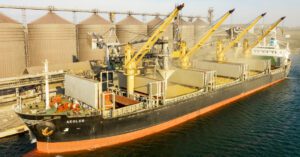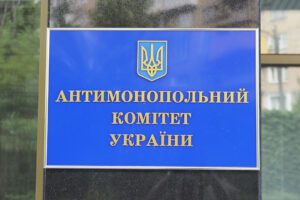
Ports of Greater Odessa on Tuesday shipped 129 thousand tons of agricultural products as part of the “Grain Initiative”, the Ministry of Infrastructure of Ukraine reported.
“Today a caravan of four ships left the ports of Greater Odessa, which will deliver 129 thousand tons of agricultural products to Africa, Asia and Europe. In particular, the bulk carrier Ince Atlantic with 44 thousand tons of Ukrainian wheat for Kenya”, – indicated the Ministry.
According to him, in the ports involved in the “Grain Initiative”, 27 ships are under the processing, they are loaded with 1 million tons of Ukrainian agricultural products.
Also in the “grain corridor” there are two vessels with the loading of 63 thousand tons of agricultural products.
A total of 569 vessels have left the ports of Greater Odessa since August 1, exporting 14.3 million tons of Ukrainian foodstuffs to Asia, Europe and Africa.

The Cabinet of Ministers postponed for another year the implementation of the resolution adopted in July 2019 to increase teachers’ salaries by 20-70%.
According to the representative of the Cabinet in the Verkhovna Rada Taras Melnichuk in the telegram channel, the relevant decision was made at the government meeting on Tuesday.
In particular, stopped until December 31, 2023, the Cabinet resolution of June 10, 2019 № 822 “On remuneration of pedagogical, scientific-pedagogical and scientific employees of educational and scientific institutions”.
As reported, on July 10, 2019, the Cabinet approved a reform of teacher pay with an increase to four subsistence minimum wage by 2023. The plan was for teacher pay to be 2.5 living wages in 2020, 3 living wages in 2021, 3.5 living wages in 2022 and 4 living wages beginning in January 2023. Later, due to lack of funds for the reform implementation in the state and local budgets, the decree was suspended until December 31, 2020. Its implementation was also postponed in subsequent years.

The Antimonopoly Committee of Ukraine (AMCU) has fined the private companies Fialka and Style-Decor UAH 92 million for collusion in the tender for the reconstruction of the Avangard stadium in Rivne, the agency’s press service has said.
According to the statement, the committee found evidence of coordination between the two companies during the participation in the tender due to which the competition between them was eliminated. The expected cost of works at the tender was UAH 202.2 mln, the AMCU notes.
For the concerted actions at the auction the companies, in addition to the fine, are banned from participating in public procurement for three years.
According to Opendatabot, the owner and beneficiary of the private industrial and commercial firm “Fialka” (Sumy) is Vahid Kurbanov. According to the company’s financial statements for 2020, it was not engaged in economic activities.
The owner and beneficiary of LLC “Style-Decor” is named Vera Rozhchuk. In 2020 the company received 151 thousand UAH of net loss and 23 million UAH of income.

Ukraine on Tuesday received from the Netherlands EUR200 million of credit funds on concessional terms through an IMF-administered account, the Ministry of Finance said.
According to its release, the loan amount bears interest at an annual interest rate equal to the IMF prime rate of interest (IMF basic rate of charge, fixed at 3.641% per annum).
The final repayment of the loan is carried out 10 years from the date of the sample of the loan, taking into account the grace period of 4.5 years from the date of the sample of the loan, the Ministry of Finance said.
The loan funds are designed to finance the cost of the general fund of the state budget, the ministry said.
As reported, in early July this year, the Netherlands announced a decision to allocate another EUR200 million to Ukraine through the IMF account. “The funds will be spent on the current needs of the Ukrainian authorities, such as salaries of civil servants, teachers, medics,” said Minister of Foreign Trade and Development Cooperation of the Netherlands Lisie Schreinemacher at the International Conference on the Recovery of Ukraine in Lugano, Switzerland.

Kyiv Cardboard and Paper Mill suffered UAH 233 mln of losses in 9 months, but intends to invest EUR75 mln in equipment
The largest Ukrainian enterprise of the pulp and paper industry of Ukraine, JSC “Kiev Cardboard and Paper Mill” (Obukhov, Kiev region) following the results of nine months of the current year received a 233.4 million UAH loss from economic activity, said the deputy head of the board of the mill Oleg Dubrovka.
“In 2012-2022 the combine received a net profit of more than 2.5 billion UAH, which was reinvested in the development of the enterprise, and only 6 million UAH was paid as dividends. This year’s financial results are affected by both the large-scale invasion of Ukraine by the Russian Federation and the seizure of assets and funds as part of criminal cases,” he said at a press conference in Kiev on Tuesday, answering a question from Interfax-Ukraine.
According to him, in particular, after the Russian invasion of Ukraine had to suspend the project of launching the production of corrugated packaging in Verkhnedniprovsk, where it was planned to create 250 jobs.
“It was planned to launch a shop for the production of cast containers (packaging for eggs) with 123 jobs, but with the narrowing of the capacity of the market of these products plus the destruction of large enterprises in the south, the direction of cast containers for this year is projected to give us a loss of 24 million UAH, and the plant had to suspend”, – explained Dubrovka.
Also, before the start of a full-scale war, “Pulp Mill Holding” (the only shareholder of the mill) had planned to renew the entire equipment fleet of “Pulp Mill Print” – both carton packaging and flexography.
Among other things he noted that with the beginning of full-scale war the Kiev Mill had problems with the departure of the personnel, problems with logistics, delivery of the finished products, we had to look for new ways to supply the raw materials. Dubrovka also noted the staffing problem and said that all requests of the mill for reservations for personnel were never supported.
“But the company’s image is also negatively affected by the ongoing asset seizures. Partners do not understand why sanctions, why arrests and why there is no reaction to our requests to the law enforcement agencies. That is why both war and criminal proceedings lead to problems for the company and, consequently, to losses,” he summarized.
According to the deputy head of the Works, the environmental project of the plant’s waste incineration was to be launched in 2022. He stressed that the financing of the projects has not been stopped, but the company has faced the fact that Western specialists do not want to go to Ukraine to install the equipment.
“That is why last week the Supervisory Board decided to budget EUR75 million for the equipment, and we will look for ways and Ukrainian specialists to install it,” Dubrovka said.
He stressed that the modernization of production requires bank financing, and the mill mostly works with subsidiary banks of foreign banks (Raiffeisen, Credit Agricole). Cooperation with the European Bank for Reconstruction and Development (EBRD) was an important milestone, but had to repay its long-term loan ahead of schedule. “Resuming work with this respected bank will require a lot of effort,” he concluded.
At the same time Dubrovka expressed the opinion that the task of all criminal proceedings against the combine is the transfer of assets to the National Agency of Ukraine on the detection, search and management of assets derived from corruption and other crimes (ARMA), which will actually lead to the shutdown of the combine.
“The power structures need to understand that to stop the enterprise is not a shopping center (like the stopped Ocean Plaza), it will lead to the loss of jobs (about 3.3 thousand people in the group of companies), and Obukhov may be left without water and heating, which today provides Kyiv KBK,” he added.
Kiev KBC is one of the largest enterprises in Europe for the production of cardboard and paper products (corrugated packaging, sanitary products) with a staff of about 2.2 thousand people.
In 2021 the mill increased the production volume by 34.2% compared to 2020 – up to 7 billion 699 million UAH, and in January-September this year it produced goods for 5.4 billion UAH, which is 3.2% less than last year.
In January-September 2021 the net profit of KKBK was 488 million hryvnias.

The producer of tobacco products PJSC “Philip Morris Ukraine” in cooperation with DTF agency organized five social spaces “Spheres of the Sweet” with working areas in Kyiv, Odessa and Lviv, equipped with generators and Starlink satellite communication systems.
According to Philip Morris’ press service on Tuesday, the social spaces can keep you warm, recharge your devices, work and drink hot tea. They will be open until Dec. 30 and can accommodate about 100 people each at a time.
“We work for a large international company with offices and stores in many Ukrainian cities. Like all Ukrainians, we look for communication during blackouts, sit in shelters during alarms and worry if we can’t contact our families. We believe that resilient companies can help to survive a blackout together, so we organized autonomous stations with electricity, internet and heat”, – the company quotes the general director of “Philip Morris Sales and Distribution” Dmitry Zinchenko.
According to him, from the first days of the launch, social spaces have been very popular among city residents and help out in very unexpected situations.
“Employees of different companies during blackouts often make a field office with us. In Odessa, for example, during a blackout, girls from a nail salon nearby moved into the sphere. And in Kiev, our space even became a place for a wedding ceremony”, – added Zinchenko.
Social spaces are located in Kiev on Lesya Ukrainka Square, 1 (Central Election Commission) and Kontraktova square (near the Ferris wheel), in Odessa in the Park of enthusiasts (Akademika Zabolotnogo 66/2v) and in the Square “Ray” (Levitan 95a), and in Lviv on Vinnichenko Street 24 (Powder Tower).
Philip Morris International, which includes “Philip Morris Ukraine” is one of the world’s largest tobacco manufacturers. It operates in Ukraine for more than 20 years, owns a factory in the Kharkov region. Before the Russian armed invasion the company employed about 1.3 thousand people. Before the war, the factory was an export hub for more than 20 countries, in particular such major markets as Japan and Egypt.